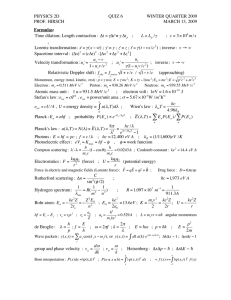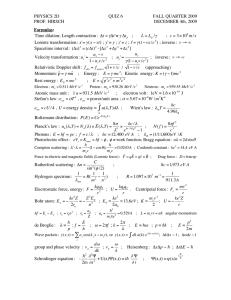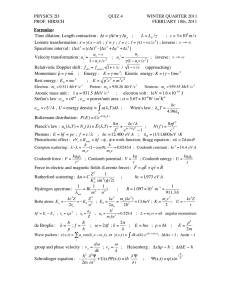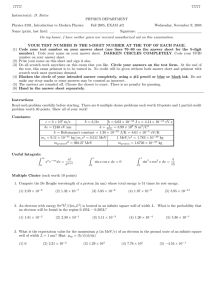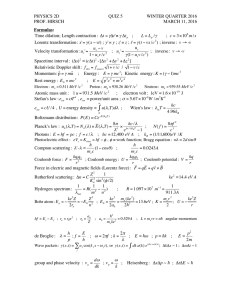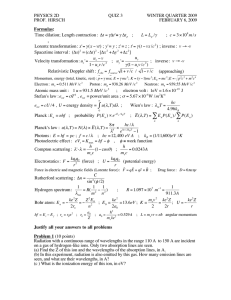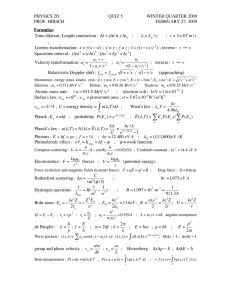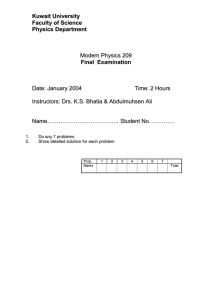PHYSICS 2D FINAL EXAM FALL QUARTER 2009
advertisement
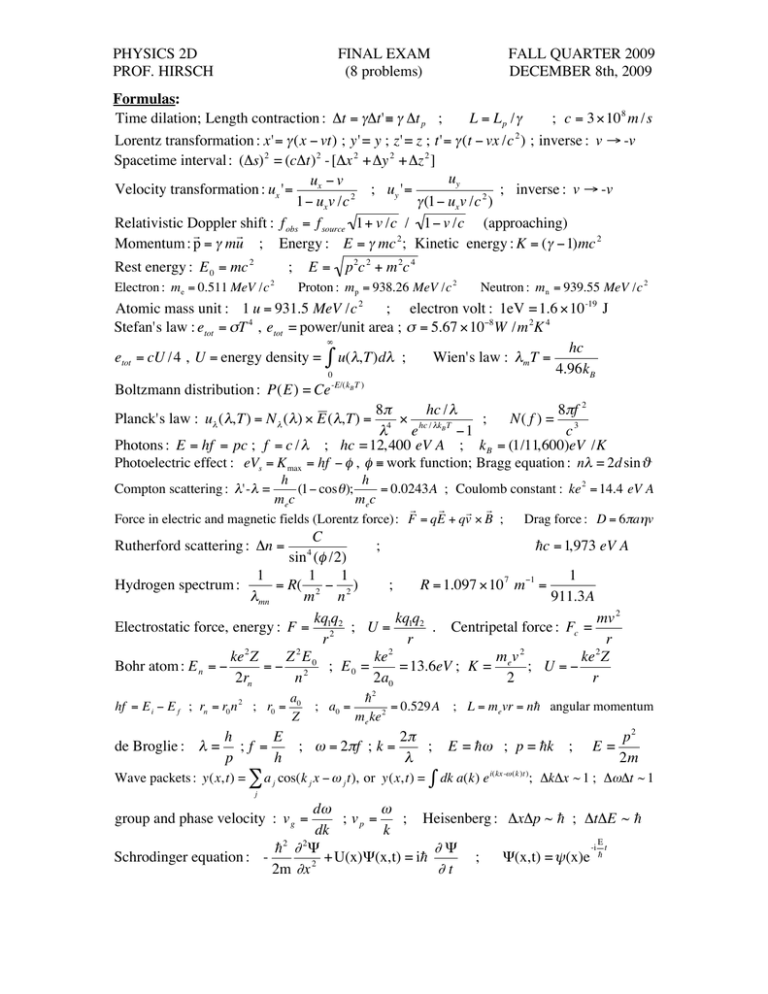
PHYSICS 2D PROF. HIRSCH ! ! ! ! ! ! ! ! ! ! ! ! ! ! ! ! ! ! ! FINAL EXAM (8 problems) Formulas: Time dilation; Length contraction : "t = #"t'$ # "t p ; L = Lp /# ; c = 3 %10 8 m /s Lorentz transformation : x'= " (x # vt) ; y' = y ; z' = z ; t'= " (t # vx /c 2 ) ; inverse : v $ -v Spacetime interval : ("s) 2 = (c"t) 2 - ["x 2 + "y 2 + "z 2 ] uy ux " v Velocity transformation : ux '= ; uy '= ; inverse : v $ -v 2 1" ux v /c # (1" ux v /c 2 ) Relativistic Doppler shift : f obs = f source 1+ v /c / 1" v /c (approaching) r r Momentum : p = " mu ; Energy : E = " mc 2 ; Kinetic energy : K = (" #1)mc 2 Rest energy : E 0 = mc 2 ; Electron : me = 0.511 MeV /c 2 E= p 2c 2 + m 2c 4 Proton : mp = 938.26 MeV /c 2 Neutron : mn = 939.55 MeV /c 2 Atomic mass unit : 1 u = 931.5 MeV /c 2 ; electron volt : 1eV = 1.6 "10 -19 J 4 Stefan's law : etot = "T , etot = power/unit area ; " = 5.67 #10$8 W /m 2K 4 # hc etot = cU /4 , U = energy density = $ u( ",T)d" ; Wien's law : "m T = 4.96kB 0 -E/(kB T ) Boltzmann distribution : P(E) = Ce 8$ hc / " 8$f 2 Planck's law : u" ( ",T) = N " ( ") # E ( ",T) = 4 # hc / "kB T ; N( f ) = 3 " e %1 c Photons : E = hf = pc ; f = c / " ; hc = 12,400 eV A ; k B = (1/11,600)eV /K Photoelectric effect : eVs = K max = hf " # , # $ work function; Bragg equation : n% = 2d sin & h h (1# cos $ ); = 0.0243A ; Coulomb constant : ke 2 = 14.4 eV A mec mec r r r r Force in electric and magnetic fields (Lorentz force) : F = qE + qv " B ; Drag force : D = 6#a$v Compton scattering : "'- " = C ; hc = 1,973 eV A sin (# /2) 1 1 1 1 Hydrogen spectrum : = R( 2 # 2 ) ; R = 1.097 $10 7 m#1 = "mn m n 911.3A kq q kq q mv 2 Electrostatic force, energy : F = 12 2 ; U = 1 2 . Centripetal force : Fc = r r r ke 2 Z Z 2E0 ke 2 mev 2 ke 2 Z Bohr atom : E n = " = " 2 ; E0 = = 13.6eV ; K = ; U =" 2rn n 2a0 2 r Rutherford scattering : "n = ! hf = E i " E f ; rn = r0 n 2 ; r0 = ! de Broglie : " = ! FALL QUARTER 2009 DECEMBER 8th, 2009 h E ;f = p h 4 a0 Z ; a0 = h2 = 0.529A ; L = me vr = nh angular momentum me ke 2 ; # = 2$f ; k = 2$ ; " Wave packets : y(x,t) = $ a j cos(k j x " # j t), or y(x,t) = E = h# ; p = hk ; % dk a(k) e i(kx -# (k )t ) E= p2 2m ; &k&x ~ 1 ; &#&t ~ 1 j ! ! ! ! d" " ; vp = ; Heisenberg : #x#p ~ h ; #t#E ~ h dk k E -i t h2 " 2# "# h Schrodinger equation : + U(x)#(x,t) = ih ; #(x,t) = $ (x)e 2 2m "x "t group and phase velocity : v g = PHYSICS 2D PROF. HIRSCH FINAL EXAM (8 problems) FALL QUARTER 2009 DECEMBER 8th, 2009 % h 2 # 2$ + U(x) $ (x) = E $ (x) ; dx $ *$ = 1 & 2 2m #x -% 2 2 2 2 2 n$x $ hn h sin( ) ; En = ; = 3.81eVA 2 (electron) 2 L L 2mL 2me Time " independent Schrodinger equation : - " square well : # n (x) = m$ 2 x 2h 1 p2 1 1 ; E n = (n + )h$ ; E = + m$ 2 x 2 = m$ 2 A 2 ; %n = ±1 2 2m 2 2 ! Harmonic oscillator : "n (x) = H n (x)e ! Expectation value of[Q] :< Q >= # " * (x)[Q]" (x) dx ; Momentum operator : p = ! ! # Eigenvalues and eigenfunctions : [Q] " = q " (q is a constant) ; uncertainty : Step potential : reflection coef : R = ! (k1 " k 2 ) 2 , T = 1" R ; (k1 + k 2 ) 2 k= #Q = < Q2 > $ < Q > 2 2m (E " U) h2 x2 % -2 # (x )dx Tunneling : " (x) ~ e -# x ; T = e -2#$x ; T =e ; x1 ! # (x) = 2m[U(x) - E] h2 r r r r -i E t h2 2 $# " # + U( r )#( r ,t) = ih ; #( r ,t) = % ( r )e h 2m $t 2 2 # h n12 n 22 n 32 3D square well : "(x,y,z) = "1 (x)"2 (y)"3 (z) ; E = ( + + ) 2m L12 L22 L23 Spherically symmetric potential: "n,l,m l (r,#, $ ) = Rnl (r)Ylm l (#, $ ) ; Ylm l (#, $ ) = Plm l (# )e im l$ r r r h # Angular momentum : L = r " p ; [Lz ] = ; [L2 ]Ylm = l(l + 1)h 2Ylm ; [L z ] = mh i #$ ke 2 Z 2 Radial probability density : P(r) = r 2 | Rnl (r) |2 ; Energy : E n = " 2a0 n 2 1 Z Ground state of hydrogen and hydrogen - like ions : "1,0,0 = 1/ 2 ( ) 3 / 2 e$Zr / a 0 # a0 " " #e eh Orbital magnetic moment : µ = L ; µz = #µB ml ; µB = = 5.79 $10#5 eV /T 2me 2me r 1 "e r Spin 1/2 : s = , | S |= s(s + 1)h ; Sz = msh ; ms = ±1/2 ; µs = gS 2 2me r r "e r r r Orbital + spin mag moment : µ= ( L + gS ) ; Energy in mag. field : U = "µ # B 2m r r r r Two particles : "(r1, r2 ) = + /# "( r2 , r1 ) ; symmetric/antisymmetric Screening in multielectron atoms : Z " Z eff , 1 < Z eff < Z Orbital ordering: 1s < 2s < 2p < 3s < 3p < 4s < 3d < 4p < 5s < 4d < 5p < 6s < 4f < 5d < 6p < 7s < 6d ~ 5f Schrodinger equation in 3D : - ! ! l ! ! ! ! ! ! ! ! ! ! h $ i $x Justify all your answers to all problems l PHYSICS 2D PROF. HIRSCH FINAL EXAM (8 problems) FALL QUARTER 2009 DECEMBER 8th, 2009 Problem 1 (10 points) Initial M Final 2v m1 m2 v A particle of mass M=1000MeV/c2 at rest splits spontaneously into two fragments of masses m1 and m2 moving with speeds 2v and v in opposite directions, as shown in the figure. v=0.4c. (a) Find m1 and m2 in terms of M according to Newtonian mechanics. (b) Find m1 and m2 according to relativistic mechanics, in units MeV/c2. (c) Find the kinetic energy of the two fragments in MeV and explain the relation between the kinetic energies and the missing mass M-m1-m2. Problem 2 (10 points) Na plate A flashlight emitting light of wavelengt 6000 A is moving towards a Na (sodium) metal plate that is at rest . The work function of Na is 2.28 eV. (a) How fast does the flashlight have to move so that the light emitted by it causes electrons to be emitted from the Na plate? Give your answer in terms of c. (b) For the flashlight moving at speed 0.8c towards the metal plate, find the maximum kinetic energy of the photoelectrons emitted. Problem 3 (10 points) An electron in a hydrogen-like ion of charge Z described by the Bohr atom model has potential energy -245 eV. (a) Find possible values of Z for this ion, at least 3 different ones. (b) Find the ionization energy of these ions for the three values of Z found in (a). (c) Find the speed of the electron, expressed as v/c, for the three values of Z found in (a). PHYSICS 2D PROF. HIRSCH FINAL EXAM (8 problems) FALL QUARTER 2009 DECEMBER 8th, 2009 Problem 4 (10 points) Suppose that instead of the ordinary Coulomb law, the potential energy for an electron in a hydrogen atom is given by the expression ke 2 a1/ 2 U(r) = " 3 / 20 r with ke2=14.4 eV A and a0 the Bohr radius. (a) Using the uncertainty principle, estimate what would be the radius of the hydrogen atom in this case. (b) In a world where U(r) would be given by the formula above rather than the ordinary Coulomb law, how tall would people be, approximately? Explain why they would be taller, shorter or the same height as people in this world. Hint: assume the uncertainty in the position is r, and minimize the total energy. ! Problem 5 (10 points) A free electron (not subject to any forces) is described by the wavepacket " (x,t) = $ dk a(k) e i(kx -# (k )t ) with a(k) given in the figure. The uncertainty in the position of this electron at t=0 is 0.5 A, and its speed is 0.1 c. You may assume it's not relativistic. ! the values of k and k in the figure. (a) Estimate 1 2 (b) Estimate the uncertainty in the momentum and give the answer in units eV/c. a(k) k1 k2 Problem 6 (10 points) electrons U0 x=0 x A beam of electrons encounters a potential step of height U0 at x=0 and is partially reflected and partially transmitted. The wavefunction for an electron (unnormalized) is " (x) = e ikx + 0.4e#ikx x<0 " (x) = Ce ik2 x x$0 with C a constant. The wavevector for the incident electrons is k=1A-1. (a) For every 1000 electrons incident, how many are reflected? (b) What is the value of the wavevector k2, in A-1? (c) What is the height of the potential step, U0, in eV? Hint: Use continuity of the wavefunction and its derivative. Use h 2 /(2me ) = 3.81 eVA 2 ! ! PHYSICS 2D PROF. HIRSCH FINAL EXAM (8 problems) FALL QUARTER 2009 DECEMBER 8th, 2009 Problem 7 (10 points) ! For an electron in hydrogen described by the radial wave function 1 r "r / 2a 0 R(r) = e 3/2 (2a0 ) 3a0 (a) Find the most probable r (in terms of a0) (b) Find < r >. 1 (c) Find r (d) How much more likely is it to find this electron at the most probable r than it is to find it at the average value of r, <r>? $ n! !Hint: use that % dx x n e" #x = n +1 # 0 Problem 8 (10 points) ! Two sodium atoms are walking down the street. One says to the other: "You know, I just lost an electron". The other asks, incredulously: "Are you sure??" (a) What is the first sodium atom's answer? (b) Give the atomic configuration for sodium. (c) Why is it not hard to believe that a sodium atom would lose an electron? Discuss in detail the physics involved, comparing with the same situation for two hydrogen atoms, two magnesium atoms and two argon atoms walking down the street. Would they be more or less likely to lose electrons? Hint: the atomic number of sodium is Z=11, its ionization energy is 5.1 eV. Z=12 for Mg, Z=18 for Ar. Justify all your answers to all problems
